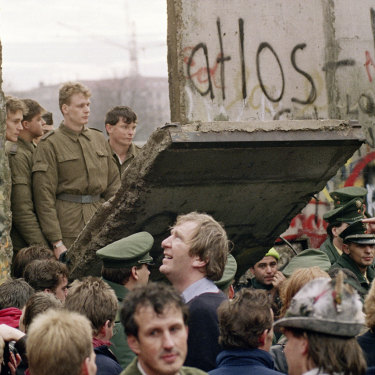West Berliners watch East German border guards open up a new crossing point in the Berlin Wall in 1989.CREDIT:AFP
Europe’s walls are back. Concrete and wire; armed patrols; fear, alienation, suspicion. A continent bristles with fortified distrust. It feels, and acts, besieged.
So I walk the battlements. I chat to a right-wing extremist, who crosses his arms proudly in front of a watchtower sprouting infra-red CCTV as he crowns himself defender of the Christian West. I’m hectored by Thracian farmers angry at the refugees trampling their vegetables. And I’m given a watermelon by a policeman turned people-smuggler who fishes in the fast, cold river between Greece and Turkey, where he sees migrants’ bodies bobbing among the tangled trees.
Thirty years ago the Berlin Wall fell, pulling the Iron Curtain down with it. Grainy video scenes were imprinted on history: a cheering, waving mass of people chiselling away at totalitarianism. This was more than just German reunification, it was a parable of liberation. A validation. A promise that as much as we push at each other, we’d much rather embrace. Yet today across the world – and especially in Europe, where this promise was made – razor wire is again stretching across borders and dividing people, physically and in pitiless cultural barriers constructed and patrolled by rekindled nationalism.
In this year’s Harvard University Commencement Address, German Chancellor Angela Merkel told graduates of her pain as a young woman walking home on the east side of the Berlin Wall, so close to the freedom on the other side. Merkel implored her audience to break down the re-emerging walls: of ignorance and narrow-mindedness, among family members and social groups, between people of different skin colours and religions. “If we tear down the walls that restrict us, if we open the door and embrace new beginnings, then everything is possible,” she told the gathered students. “Walls can collapse. Dictatorships can disappear.”
I’m not as erudite as Merkel, and I can’t get Pink Floyd earworms out of my head. “All in all it was all just bricks in the wall” … “Together we stand, divided we fall.” So I decide to call Roger Waters.
The Wall, Pink Floyd’s largely Waters-written semi-autobiographical 1979 album, tied a rock star’s personal breakdown to themes of alienation, withdrawal and hate – as Waters has said, “If you isolate yourself, you decay.” It became the bestselling double album of all time, and gained unexpected political potency when, eight months after the Berlin Wall fell, Waters staged a huge concert at the Brandenburg Gate, where half a million members of the city’s divided community reunited in song.
“There was a very brief and possible point at which the world, geopolitically, might have moved forward,” Waters says by phone from New York, as he recalls that night. Now he, too, sees walls going up again. “It more than saddens me. It angers me beyond measure. It’s miserable and it’s scary as shit.” Reflecting on the impetus for new walls, he settles on fear. “Fear is an exercise in control. It’s always divide and conquer. If you can persuade the people who vote for you that the problem is people trying to flood through the borders, you can get them to do almost anything. You can get them to put up with any prohibition.”
Building Walls is the title of a 2018 report from Centre Dèlas, an independent Barcelona-based institute dedicated to the study of peace. It recalls the November 1989 fall of the Berlin Wall, “marking what many hoped would be a new era of co-operation and openness across borders”. Authors Ainhoa Ruiz Benedicto and Pere Brunet write that the opposite seems to have happened. “Edifices of fear, both real and imaginary, are being constructed everywhere, fuelling a rise in xenophobia and creating a far more dangerous, walled world for refugees fleeing for safety.”
It’s a global phenomenon, even putting aside US President Donald Trump’s rise on the back of a promised new wall between the US and Mexico. In Europe the report tallies up almost 1000 kilometres of barriers – the equivalent of more than six Berlin Walls – that have been built since the 1990s, most constructed in the past five years to prevent displaced people entering the continent. It counts 15 post-Cold War walls built by 2017, on the borders of Spain, Norway, Hungary, Greece, Macedonia and elsewhere.
“Much of Europe has turned itself into a fortress excluding those outside – and in the process also increased its use of surveillance and militarised technologies that has implications for its citizens within the walls.” The physical walls parallel “walls of fear stoked by xenophobic parties”, say the report’s authors, shaped by the “post-9/11 security paradigm”. So I decide to go see them. To trace the line through fear and compassion in Fortress Europe.
KIRKENES
NORWAY
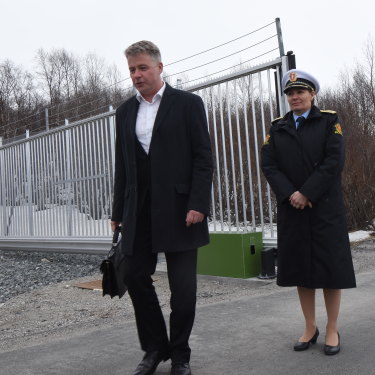 |
At just 200 metres long, the Storskog border fence at Kirkenes, Norway, is widely seen as symbolic.CREDIT:
THOMAS NILSEN/BARENTS OBSERVER |
As the plane descends to this small town in far north-eastern Norway, the land beyond the buzzing propellers is glacier-scraped, patterned with lakes of snow melt. We are hundreds of kilometres above the Arctic Circle. This is the border between Norway and Russia. Even at lunchtime, the August sun can’t heave high into the clear blue sky. It slants through the windows of Kirkenes’ Borderland Museum, which opened in 2009 to tell the story of a land that has seen many transitions between nations and cultures. It strikes off the handlebars of the museum’s incongruent display of old bicycles. Some have torn, red stickers with Russian script on them.
In August 2015, at the height of what became known as Europe’s Syrian migration crisis, refugees suddenly appeared here, 4000 kilometres from home, crossing into Norway from Russia on bikes. More than 5000 of them arrived within a few months, to a town of barely 3500. How they got here was unclear. But the very unlikeliness of their arrival spoke volumes of their desperation to reach the West. “It started small, sort of,” says Bodil Dago, a curator at the museum. “All of a sudden they were there. And all of a sudden it was finished. It was handled and they were shipped away [for resettlement and processing of their asylum claims elsewhere in Norway]. This is a border area. You don’t want to stay.”
Museum registrar Camilla Carlsen remembers the refugees as sociable and outgoing, and agrees that the influx “only lasted for a few months actually”, but admits to being afraid during that time. The refugees were temporarily housed in a sports hall next to the local school. “If someone had freaked out, they’re only, like, 10 steps away from a school for, like, hundreds of children. That’s what you think about. We are used to being far away from everything, and isolated, and suddenly they were there and walking along the street. And I have five girls, teenagers, and some of [the refugees] are really young men, and really beautiful.”
By the end of the year, the Syrians had stopped coming. Again, nobody here really knew why.
Then came the border wall. A steel fence was announced in August 2016, after eight months in which no one had bid for asylum via the northern frontier. The announcement was made by the justice minister from Norway’s right-wing, anti-immigrant Progress Party, which had joined the governing coalition in 2013.
Thomas Nilsen is editor of the local newspaper, the Barents Observer. He says the 3.5-metre-high fence was viewed as “a symbolic act from Ministry of Justice politicians who needed to show they were able to do something ... People were more laughing about the fence than taking it seriously.” The wall was just 200 metres long. “If a person can escape out of Damascus or Aleppo, cross through the border zones in Syria over to Turkey and manage to go up to Moscow or St Petersburg and up all the way across the Kola peninsula to the border of Norway, then that person will also be able to walk around a 200-metre fence,” says Nilsen, with dry Norwegian sarcasm. “Walking around it is very easy.”
The Russians already had a much bigger, longer fence along the same border, a legacy of the Cold War – and had been letting refugees through the gate. “If they want the border to be closed, then no one will get through,” says Nilsen, matter-of-factly. The Russian fence made the Norwegian one doubly redundant. Not only that but, once the Norwegian fence was finished, and as the winter frosts began to freeze the ground, a quarter of its length had been built too close to Russia. So the fence had to be moved – by a few centimetres. “We’re not proud of that,” says the museum’s Dago. “It’s not very helpful to the local population. It wasn’t our idea. It’s just … you know.” Carlsen calls it a “joke”, a “political statement [that] has nothing to do with anything”.
I ask the Observer’s Nilsen about the real dangers in Kirkenes. Refugees? Polar bears? Car accidents? There are no polar bears, he says, and “people here are the world’s best at driving in winter”. Mostly, Norwegians worry about Russia and its regular, provocative military exercises in the sea off Kirkenes. Carlsen’s husband was taught as a child that if someone waved from the Russian side, you did not wave back. But since the fall of the Iron Curtain three decades ago, there’s been increasing border traffic. The Norwegians go to Russia to buy half-price petrol, the Russians come to Kirkenes to buy nappies.
Dago has one more story about the wall, related to an exhibit upstairs in her museum: “We have these big crabs coming from Russia,” she says. “They don’t respect the border. They started to come here in the beginning of the 1990s. They damaged the fishermen’s nets, they ate the food of the fishes, and it was a really big problem.
“But today we’re earning lots of money from them. They are exported, I think to Japan. When I think about borders, I think sometimes they are a good thing. Otherwise you couldn’t control who is coming into your country. But you can’t stop the crabs. That’s difficult.”
There’s a lesson in there somewhere: about how hard it is to make a border impermeable, and the opportunities you might miss if you do.
RÖSZKE AND ÁSOTTHALOM
HUNGARY
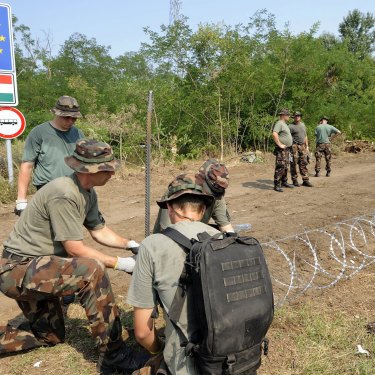 |
Members of the Hungarian Defence Force erecting a border fence in 2015 to stem a wave of refugees.CREDIT: GETTY IMAGES
In September 2018, Hungarian Prime Minister Viktor Orbán stood defiantly in front of the European Parliament in Strasbourg, his blue suit buttoned over his blue tie, his eyebrows arched. He told off “socialists and liberals” for their condescension, their ignorance of history. “We have built a fence,” he said. “We have stopped illegal migrants. Hundreds of thousands of them. We have defended Hungary and we have defended Europe.” In an echo of an Australian PM two decades earlier, Orbán said “we will protect our borders and we will decide who to live together with”. Replied former Dutch foreign minister Frans Timmermans, “We are going back to a European history none of us want to see again.”
During Europe’s 2015 migration crisis, Hungary was the first country to shut its gates, denying the tide of a million refugees a path to the north-west, reinforcing its southern border with a new fence and deploying armed guards along it. I was there, on the Serbian side, when masked, baton-wielding, Hungarian riot police tear-gassed, pepper-sprayed and beat back a crowd of Syrian and Afghan refugees bound for Germany. They fled, finding a path west instead, across a minefield into Croatia. Now I’m back in Hungary, approaching the Hungary-Serbia border, this time from the north.
A laneway at the small Hungarian border town of Röszke leads down to cabbage fields. A home abuts the razor wire. Around the property’s corrugated-iron gate a striped hat pokes, followed by a ponytail and a gold earring framing a friendly face. Zoltán Szucs, 63, ushers me and my fixer into his home, and insists we sample his pálinka, Hungary’s eye-watering national spirit. Szucs sits under the boar’s head on his wall and tells me he is a retired farmer who now makes a bit of money from metalwork, making fences and garage doors. He likes fences, especially the one next to his house.
“I am thinking now this kind of fence should be installed all over the world,” he says. “Even bigger. Just like in America.” He respects Trump and he respects Orbán, whose administration faces widespread allegations of corruption – “I don’t really care how much he steals.” He doesn’t respect the Germans who opened their borders and “are just crying at home like babies now while [migrants] are raping their wives and kids”. The migrants, he says, “cannot assimilate and they can do terrorist attacks”.
The other day, he heard on the CB radio that maybe the fence doesn’t work. So he went down and threw a stone at it. A light started flashing immediately, and the loudspeakers fired up, announcing in three languages that it was illegal to cross the fence and that they should go to the closest transit zone. Szucs approved.
Szucs’s wife, Iren, 69, nods. Before the fence, she says, one time about 70 migrants arrived at their house and she was so scared she dropped her watering can and ran inside. “We don’t need them,” she says. “I have granddaughters and I’m really afraid what kind of future they will have in this world. I saw many horrible things during Communism, but this is worse.”
From Röszke, I drive west through leafless, wintry timber plantations to nearby Ásotthalom, where the local mayor, László Toroczkai, made global news in 2015 for an over-the-top anti-immigrant Facebook video. At its climax he stood accessorised with dark sunglasses, chiselled face, and arrayed border guards. The tag line: “Hungary is a bad choice. Ásotthalom is the worst.”
Today, the 40-year-old is in jeans and a camouflage jacket. Snowflakes drift down around us as we stomp to the car to take a look at the border. “They rejected me with my idea, first time in 2014,” says Toroczkai. He wanted the fence before it was popular. “Then this mass immigration started here and Ásotthalom was the main target.”
When the wave of Syrian refugees started crossing from Serbia into this poor district, it was “total chaos”, the former journalist turned politician and far-right activist says. “Thousands,” he says, “totally unknown people without control, so terrorists, criminals could be in the crowd. They especially like to arrive by night … they knock on your window. You wake up every night, you open the window and there is Islamic State. They want to charge their smartphone in your house … or they wanted somebody to call a taxi. Of course it is not normal. We live in a farm because we prefer the calmness, you know?” He says he was never scared because he has “very good dogs”. But he tells the story of a woman elsewhere in the forest who hid under her bed when 30 young Syrian men “appeared in her house” and stayed all night eating her food.
So he lobbied the government to build a border fence. “First time, the Hungarian government rejected my idea and they said it’s totally crazy … [Then] I remember the day when the Hungarian foreign minister announced on TV that they will erect this border fence. That was the happiest day of my life. The most beautiful. Of course I am very proud of this iron fortress.”
He followed up by banning mosques from his town (there aren’t any, and there are just two Muslim townspeople). He banned the Muslim veil and muezzin, too, and for good measure “the homosexual political propaganda” was also outlawed. “This is a Hungarian Roman Catholic town and we want to preserve our culture,” he tells me defiantly, drawing the familiar far-right comparison to the defence of Europe against Turkish invaders centuries ago. “I protect Europe.”
KASTANIES AND TYCHERO
GREECE
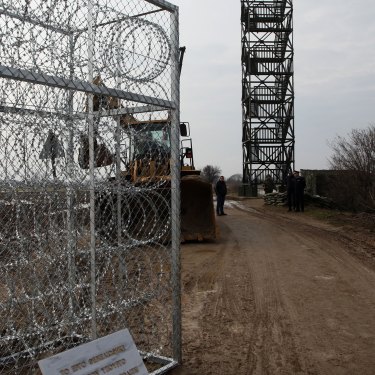 |
Part of the border wall at Kastanies on the Greece-Turkey border, erected in 2012 to stop refugees from the south.CREDIT:AFP
The road north from the Aegean Sea divides snow-dusted fields, tracking the fast-flowing Evros River upstream. Across the flat floodplain lies Turkey. This historical land, Thrace, has seen borders redrawn across it many times over millennia. Right now it’s split between Greece, Turkey and Bulgaria. It is Europe’s south-eastern edge, and the closest point to Syria.
This was the first frontline that made headlines during the refugee crisis. In the town hall in Kastanies, on the Greece-Turkey border in far north-eastern Greece, the local women’s association ply me with coffee and biscuits and opinions, talking chaotically and loudly over each other, puffing on cigarettes, telling me they have no problem with refugees, then telling me the problems with the refugees.
Kastanies is a tiny place of barely 100 inhabitants, mostly farmers. They used to make brooms here, but demand dried up. The young people left. The discos and most of the cafes closed, and so did the cinema. As Greek-Turkish relations warmed, they removed the minefields from their 1974 conflict off the border, and more and more migrants started popping up in the cornfields, where the tall stalks mean “you don’t know who you’re going to meet”, says one woman. “We started locking our doors,” says another. “In the old days we left the keys in the car and we left our doors open.”
They gave the refugees food and warm clothing. It gets cold in these hills. But the numbers went up and up, with 55,000 detected in 2011. And so a wall went up at the end of 2012. About 10 kilometres of fence, across the entire length of the land border with Turkey (the rest is the Evros River). “The fence did a lot of work,” says one of the women. “It was like a knife cut the border … I’m for the fence, I agree with the fence. I want the borders to be closed and I want us to be safe. I think someone who wants to go to another country can go the legal way.”
Katerina Liberidou, 62, vegetable farmer and vice-president of the Kastanies women’s association, says a refugee woman turned up at her house with a three-month-old baby and mastitis. She bought her cream from the pharmacy, gave them a bed for the night, bought nappies and food. “We care about refugees. Every time we help them. We are not heartless people, if she knocks on the door in the night time you are not going to close the door in their face. But we have these questions. What’s going to happen to our country? There’s no plan.”
Local baker and municipal president Stavros Tzamalidis stands sternly behind his counter and agrees. “Most of us here in Greece are refugees. We had refugee grandfathers, grandmothers. We know exactly what it is [like]. We feel compassion, we understand the condition.” But before the fence the crossings were “beyond control”, with refugees sleeping in the fields and nobody taking care of them or knowing what to do. “All the production, the fields were totally destroyed, that was the problem … The people said, ‘Please do something to protect our fields, protect our houses, protect us.’ And then the government decided to construct the fence.”
However, the fence has just displaced the problem. There’s an obvious way around it: swim the Evros.
A half-hour downstream in the small village of Tychero, ex-policeman Nikos Karadedos, 67, invites me into his home. He gives a big, welcoming smile. Later, he will offer me a small watermelon from his garden. His teenage daughter does her best to ignore us and concentrate on a TV show called My Style Rocks. Wood crackles in the stove. Nikos’ work, he says, was to “push back the migrants”. Those whom authorities had judged not to be refugees would be put in a boat and taken back to Turkey. He drove the boat, “told them, ‘You have to take this road down there, bye bye now.’ ”
For 15 years he did this. Then during the refugee crisis he found a lucrative sideline. For €100 to €200 per person, he would smuggle Syrians back to Turkey: those who needed to get back home but didn’t have the papers. “I had a friend, a Syrian himself, and whenever he heard of other Syrians who wanted to return home, he called me. I had a boat and I had somebody who checked the river shores for us with binoculars.”
He was caught and spent a year in jail. He’s still angry. “It’s not so wrong to help someone to go back to Turkey if he wants to go back to his country. This is not a crime. To help someone cross the river. Greece should give me an honour, not put me in jail.”
Now he fishes the Evros for the huge local catfish known as goulianos, which he gives to neighbours or takes to the local tavern to cook up and share. On the river, he sees bodies. Last year, he found a woman caught in the branches of the trees in the river. A week later he found someone identified as her husband, drowned, too. Two months ago, a man came up to him. “His wife and three kids drowned. He asked me to help find the third kid because they had found two but he couldn’t find the third. He was crying. He wanted to pay me, I said, ‘No, I don’t want money.’ We tried to find the body. But we were unlucky. The fence is nothing. It doesn’t protect anyone.”
CEUTA
SPANISH ENCLAVE
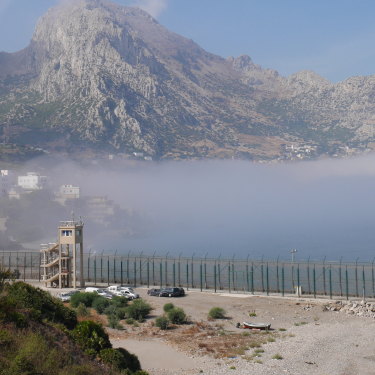 |
Looking west from Ceuta across the border fence to the Moroccan mountain Jebel Musa.CREDIT:NICK MILLER
|
Africa looms from the horizon as the ferry from Gibraltar chugs south across the straits. Dolphins leap and squeak in the warm water, and the sun sets over the hills of Morocco, casting a long shadow over Fortress Europe’s southern border. This is Ceuta, covering 18.5 square kilometres, one of Spain’s two enclaves on the African coast. Here, long before the recent refugee surge, migrants sought to climb the tall border fences, stow away in hidden compartments in cars, float round the headlands.
This Roman naval base has been fortified for at least 1500 years. Its royal walls are up to 1000 years old, and held back Sultan Mulay al-Yazid’s army for 26 years in the extraordinary Sieges of Ceuta.
But those walls are now tourist attractions. The real walls are down the narrow strip of land towards Africa proper: double-spaced wire dotted with watchtowers that wind through the steep scrubby hills, regularly charged and overcome by the determined and the desperate, in scenes that occasionally erupt into pitched battles against Spanish security forces, deploying aerosol can flamethrowers and faeces-filled bottles as missiles.
All is quiet here today, though. A long queue of Moroccans waits patiently to pass back through the heavy security, shopping bags in each hand, chatting among themselves. The fence extends down the sand into the sea, and a guard tells me to put my camera away.
Up the road in Ceuta town I find Jose Rivera, a local archaeologist and tourist guide, in a bustling city square eating tapas with his family. He is smiling, generous and idealistic, taking me through the tangled history of this place with a thick, sibilant accent. He tells me of the mythology of Ceuta, “the place the sun died”, and its place in ancient stories about the Tree of Life and the Fountain of Eternal Life. He points to the mountain, which the locals call The Dead Woman, that used to be considered the edge of the known world. Ceuta’s 14th-century flag bears two keys: “The port for Europe and the port for Africa.” Everyone wanted to conquer Ceuta.
And then, in August 1415, everything changed. The Portuguese navy took this city. “There is a change in mentality,” says Rivera. “It is the Moors against the Christians.” Since then, he says, this city has turned its back on Africa. Even today, its citizens look resolutely north, knowing more about events in Madrid than Morocco. “When the Berlin Wall fell, I thought I was witnessing a historic moment,” Rivera tells me. But he points to a more recent point of change: the 2007-09 global financial crisis, which fed despair and fear. That fear is felt daily here.
“Massive assaults on the Ceuta fence are part of the daily life [here],” he says. “This increases our citizens’ rejection of illegal migration. And for [the migrants], Ceuta is a prison, their gaze is set on the richest regions of Europe.” The only route to the Spanish mainland is by ferry, and there are patrols at the port. The mentality of the people of Ceuta is “only for sea, and Spain”, he says.
“It’s not open. They think like they are on an island. And it changes all the landscape. The buildings are tall, the streets are narrow. They closed the gate.”
2/11/2019
|
|
|
